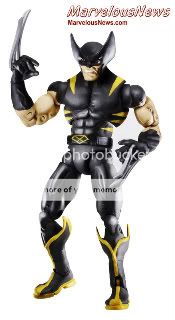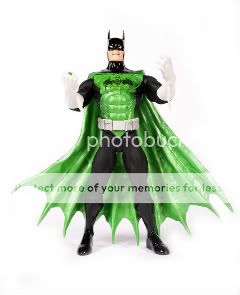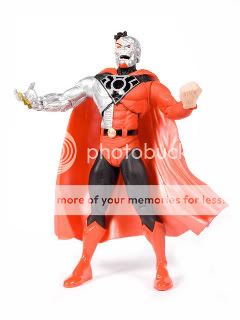* On some alternate Earth that is home to a Sean T. Collins with more money, more shelf space, and an even more absurdly patient wife, that Sean T. Collins has quite a few action figures for grown-ups, like the DC Direct Green Lantern Series 3 figures reviewed at FarePlay and the Target-exclusive Red Hulk Build-a-Figure Marvel Legends wave on display at Marvelous News (via Topless Robot). Stranded here in the infant universe of Qwewq as I am, however, this present Sean T. Collins can merely observe that action figures of superheroes and the stories that they are based on both bear witness to the simple fact that taking a character and changing his color scheme around is awesome.
Also, the Sinestro Corps storyline was great.
* Speaking of alternate Earths, Bruce Baugh imagines what the Star Wars movies would have ended up like had Obi-Wan’s original story about Darth Vader and Anakin Skywalker been the literal truth. He prefers this what-if scenario, me not so much (the prequels’ bobbling of Anakin can be ignored, while “Luke, I am your father” would be sorely missed).
* And speaking of Bruce Baugh, he (and his commenters) draws our attention to a couple of cases in which enterprising World of Warcraft players managed to loose gigantic, near-indestructible, killcrazy creatures into normally peaceful environments. Hilarious carnage results! As with an earlier incident in which players used their in-game pets to transmit a blood-borne pestilence from a dying demigod to an enemy city, thus wiping it out, WoW’s corporate overlords (the real gods of the game, apparently) quickly undid the catastrophic results of these ingenious shenanigans. I don’t play the game and maybe I’d feel differently if I did, but don’t you think they should have just let it be? It seems to me that if you are a resident of a fantasy world that’s crawling with bloodthirsty beasts and demonic entities large and small, roughly based on our own medieval past, the occasional apocalyptic plague and/or out-of-nowhere Godzilla attack is just part of the cost of living. Or perhaps it’s just that, as with that infamous massacre of the in-game memorial for an IRL deceased player, I’m amused and fascinated when players use the rules of a highly structured world against it, as it were. On the other hand, I can see how allowing such maverick moves to go forward unchecked would set up a lousy incentive structure whereby players would spend more time testing the boundaries of fairplay than actually playing. Then again, I’m sure that’s the case with a goodly number anyway.
* Jon Hastings argues that contra The Blair Witch Project (which he didn’t even like), Cloverfield‘s first-person hand-held camera conceit never rises above the level of gimmick, providing some grist for conversation among critics but never really influencing the stylistic and staging and writing choices made by the filmmakers. I think he’s mostly right, except that the limited perspective made for a hellaciously effective slow-reveal for the monster. I think the audience would have gotten pretty impatient if the filmmakers hadn’t allowed themselves that excuse.
* In the comments at this very blog, And Now the Screaming Starts’ CRwM questions whether nihilistic old Frank Miller has the proper sensibility to properly optimistic old Will Eisner’s worldview in The Spirit. I think he’s being willfully uncharitable to Miller (eg. jokingly singling out a sole comment Miller made about humanizing the Spirit by making him trip after a rooftop leap as though that’s as far as he’s going to go on that score), but I suppose more importantly I think he mischaracterizes Eisner (some of his later works are breathtakingly cynical), Miller (it’s tough to think of a creator as obviously in love with his characters as Miller with his Sin City crew or Batman), and whether Miller views the darkness of his own work as a sign of maturity (he’s always struck me as quite knowingly a kid in a candy store).
* Joe Quinones has finished his pretty rad series of Scott Pilgrim drawings done in a more “mainstream” style. (Via Scott Pilgrim creator Bryan Lee O’Malley.) Here’s Knives Chau:
As with Kevin Huizenga’s drawings of C.F.’s Powr Mastrs characters, I could stand to see a lot more of this sort of thing.
* Chris Butcher has posted a long out of print interview with Black and White cartoonist Taiyo Matsumoto, including a lengthy bibliography. The interview’s from 1995, which god help us all was thirteen fucking years ago.
* Finally, your quote of the day comes from Matthew Perpetua in response to Rich Juzwiak’s wonderfully repetitive “I’m not here to make friends” reality-show cliche montage:
Maybe that should just be the official motto of this country in the 00s.
America: We’re Not Here To Make Friends.








5 Responses to Carnival of souls